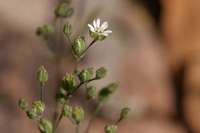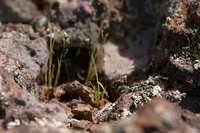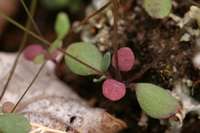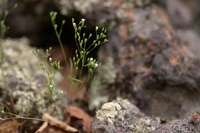Duration: Annual
Nativity: Native
Lifeform: Forb/Herb
General: Delicate erect annual to 20 cm, sparsely branched, with internodes longer than leaves, glabrous to minutely glandular, with a taproot to 1 mm.
Leaves: Opposite, rarely pseudoverticillate, glabrous, linear to narrowly oblong, 5-25 mm long, 0.5-1 mm across, often involute and coiled from tip downward, apically obtuse to acute, with entire stipules 0.2-0.8 mm long.
Flowers: Inflorescence of terminal many-flowered cyme, the peduncles 1-5 cm long, glabrous to minutely glandular, with ovate bracts, 0.5-1 mm long, equaling or exceeding the pedicels, with 5 ovate sepals, these 1.5-3.5 mm long, narrowly ovate, somewhat reflexed at the apex, petals, 5, 1.2-2.5 mm long, bifid about half their length, the lobes linear, obtuse or acute.
Fruits: Capsule 1.5-2 mm long, 5-20 seeded.
Ecology: Found in a range of habitats from pine forests and woodlands to pine-oak woodlands, canyon bottoms to ridges, from rocky soils and ridgetops to deep soils in dry canyons from 5,000-9,000 ft (1524-2743 m), flowers July-October.
Distribution: Ranges across Arizona to Colorado, south to southern Mexico and into Baja California.
Notes: Not well described in recent literature, this species description draws from Duke 1961, who characterized the holotype D. leptophylla as being D. leptophylla var. leptophylla. Distinguished by the bifid petals and the generally linear leaves.
Ethnobotany: Unknown
Etymology: Drymaria comes from the Greek drymos for forest, while leptophylla means with slender leaves.
Synonyms: Drymaria tenella
Editor: SBuckley 2011








